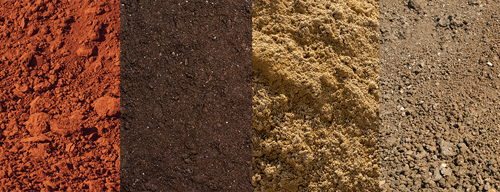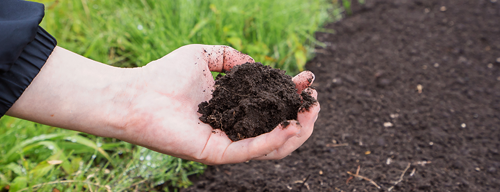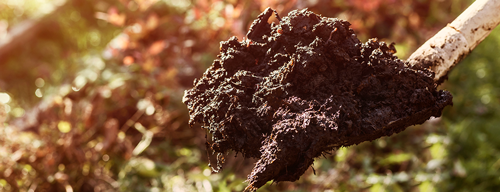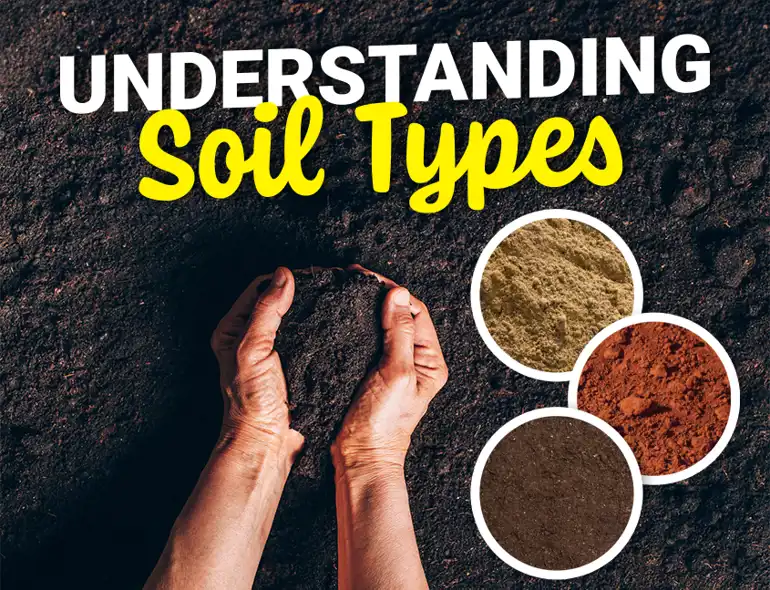Believe me, there's more to soil than just being the thing we try to scrub out of our nails after a good day in the garden! It's the secret superpower behind a successful garden, and understanding it is key to making your plants feel at home. So, grab your cup of joe, and let's dig a little deeper together.
Why is Understanding Soil So Darn Important?
Here's the thing about soil – it's not just dirt. Far from it. It's a vibrant, bustling city of organic matter, minerals, and life. The right type of soil can turn your garden into a lush paradise, while the wrong one can leave you dealing with a plant ghost town. Through years of talking to plants (and yes, they do listen), I've come to understand the enormous impact of the humble soil.
What's Your Type? Understanding the Basic Soil Types

If soil was a superhero team, it would consist of Sand, Silt, Clay, and their leader, Loam. Each has their quirks, and knowing these can be the difference between a thriving garden and a wilting mess.
-
Sandy Soil: You know the feel of beach sand running through your fingers? That's sandy soil for ya! It's loose and gritty and drains faster than a toddler can find a mud puddle. But while it's a paradise for drought-loving plants, water-loving species might find it as inhospitable as a desert.
-
Clay Soil: If sandy soil is like a sieve, clay soil is like a sponge. It's sticky when wet, and when dry, you'd think you've discovered a new source of pottery material. It's fantastic at holding onto nutrients, but its water retention might have your plants gasping for air. But fear not! With a bit of tweaking, clay can still be a plant's best friend.
-
Silt Soil: Imagine the silky smoothness of flour. That's what silt soil feels like. It's the Goldilocks of soils – not too coarse, not too fine. It holds more water than sand, but drains better than clay. Sounds perfect, right? Not so fast. It's prone to packing down, reducing air spaces that roots need to breathe. Still, with some TLC, silt soil can be your garden's diva.
-
Loamy Soil: This is the soil type that makes gardeners do the happy dance. Loamy soil is the best of all worlds. It's a balanced mixture of sand, silt, and clay, offering excellent structure, good drainage, and plenty of nutrients. Your plants will throw a party in your garden with this soil!
How Do I Identify My Soil Type?

In gardening, knowing is half the battle. But how do you figure out if your soil is a beach or a pottery workshop, a diva or a dream? Here are a couple of straightforward tests to try:
-
The "Form a Ball" Test: This one's simple. Grab a handful of moist soil and try to roll it into a ball. If it holds its shape and doesn't crumble when you open your hand, you're likely dealing with clay or silt. If it falls apart faster than a toddler's tantrum, it's probably sandy soil.
-
The "Feel" Test: Get tactile with your soil. Rub a little bit of moist soil between your fingers. If it's gritty and rough, say hello to sand. If it's smooth as a silk scarf, you've got silt. And if it's sticky enough to glue together your holiday decorations, you're working with clay.
Soil Texture: More Than Just a Feeling
You might be thinking, "Isn't soil texture just about how soil feels?" Well, my friend, soil texture is a bit like an onion - it's got layers. It's about the size of those tiny particles that make up your soil, and how they're arranged.
-
Sandy Soil: Sand particles are like the boulders of the soil world. They're the largest and, like a badly arranged rockery, leave lots of gaps. This is why sandy soil is quick-draining, but also why it can't hold onto water and nutrients very well.
-
Silt Soil: Silt particles are the middle kids, smaller than sand but larger than clay. They pack together more closely, holding water better than sand but with more drainage than clay.
-
Clay Soil: The teeny-tiny clay particles snug up close together, which is great for holding water and nutrients, but not so great for drainage.
-
Loamy Soil: Remember our dream soil? The combination of sand, silt, and clay particles in loam means it holds moisture and nutrients well but still allows for good drainage and air movement.
How Acidic is Your Soil? Understanding Soil pH
Ever wonder why your neighbor's hydrangeas are a different color than yours, even though you've sworn you bought the same variety? The magic word is pH.
-
Acid Soil: Got blue hydrangeas or rhododendrons in full swing? You're likely dealing with acidic soil. Acidic soil has a pH less than 7, and it can be a heaven for acid-loving plants. But if you've got plants that prefer neutral or alkaline conditions, they might look like they've just pulled an all-nighter.
-
Alkaline Soil: If your hydrangeas are blushing pink, you've got alkaline soil. This type of soil has a pH above 7. Like acid soil, it's great for plants that like those conditions, but not so much for those that don't.
-
Neutral Soil: Sitting pretty with a pH of 7, neutral soil is the Switzerland of the soil pH world. Most plants are comfortable in neutral soil, so if you've got this, give yourself a pat on the back!
Taking the Soil's Pulse: Checking Your Soil's Health
When it comes to soil health, compost is like a multi-vitamin and organic matter is like the magic elixir of life. By adding compost or organic matter to your soil, you're not just improving its structure; you're adding nutrients and feeding the soil organisms that help decompose organic matter and unlock nutrients for your plants.
But how do you know if your soil needs a health boost?
-
Color: Healthy soil is a deep, rich color – think dark chocolate or a well-brewed cup of joe.
-
Smell: It should have a sweet, earthy smell – like a forest after a rainstorm.
-
Life: Healthy soil teems with life. If you see worms, insects, and other soil critters, it's a good sign.
How to Improve Your Soil: The Gardener's Guide

Blessed with clay that's stickier than your Grandma's treacle pudding? Or maybe sand that's drier than a comedian's wit? Fear not! I've got a few tricks up my sleeve to help you improve your soil, no matter what type you're grappling with.
-
Add Organic Matter: Organic matter is the soil's best friend. It improves soil structure, adds nutrients, and encourages beneficial soil organisms. And, like a good friend, it helps both sandy and clay soils. It increases water retention in sandy soil, and improves drainage in clay. So don't be shy about adding compost, well-rotted manure, or leaf mold to your soil.
-
Grow Green Manures: Don't have a compost heap? Green manures might be your next best bet. These are plants grown specifically to be dug back into the soil, improving its structure and adding nutrients.
-
Use Mulch: Mulch is like the soil's personal bodyguard. It protects the soil from erosion, suppresses weeds, and as it decomposes, adds organic matter to the soil.
Embracing Your Soil Type: The Art of Adaptation
If improving your soil sounds like too much hard work, or if you're just a fan of the "love the one you're with" philosophy, then why not adapt your garden to suit your soil type?
-
Sandy Soils: These soils are great for plants that like free-draining conditions. Think Mediterranean herbs like rosemary and thyme, or drought-tolerant plants like sedums.
-
Clay Soils: Wet winters and dry summers? Plants that can cope with water logging and dry conditions will love your clay soil. Look out for robust plants like Japanese anemone or daylilies.
-
Silt Soils: The good moisture retention of silt soils makes them ideal for moisture-loving plants. If you have this soil type, consider yourself lucky!
-
Loamy Soils: With a great balance of drainage and moisture retention, loamy soils can support a wide range of plants. In fact, it's easier to list what won't grow well in loam!
Understanding Soils: Key Takeaways
I know, I know, that's a lot to take in. But here are the most important points to remember:
-
Soil Type: The type of soil you have depends on the proportions of sand, silt, and clay particles.
-
Soil Texture: This refers to the size and arrangement of the particles.
-
Soil pH: The acidity or alkalinity of your soil affects which plants will thrive.
-
Improving Soil: You can improve your soil by adding organic matter, growing green manures, and using mulch.
-
Adapting to Soil: Or, you can adapt your garden to suit your soil type.
Further Reading:
I hope this article has inspired you to get out there and start digging into the world of soils. Remember, it's not just dirt – it's a living, breathing ecosystem that supports all the wonderful plants in our gardens. Happy gardening!
Are you following us on Facebook, Twitter or Tiktok? If not we'd love to have you as part of our burgeoning community of chefs and growers! Also leave a comment below about your experiences with different soil types and get the conversations started!



